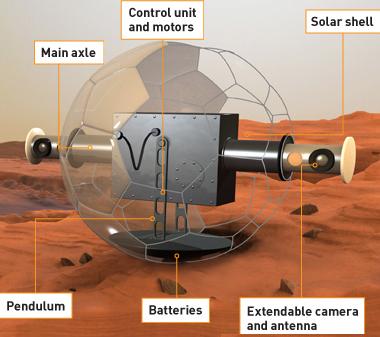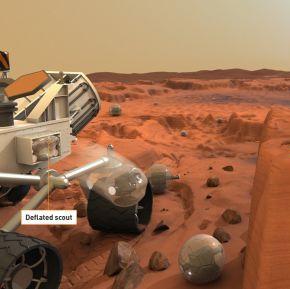From the next generation of Mars vehicles, spherical robotic assistants will be rolled out to explore the surface

This fall (this figure may change due to the economic crisis, the original article was written before the crisis) NASA intends to launch the largest Mars rover to date - Mars Research Laboratory (MRL) whose dimensions are similar to those of an SUV - at a cost of 1.8 billion dollars. Although MRL will be able to carry five times more equipment than the Spirit and Opportunity rovers already patrolling Mars, researchers from Sweden claim that even more impressive feats could be achieved with the help of a fleet of robotic assistants. Frederic Brohn, CEO of Angstrom Aerospace, and his colleagues designed small inflatable trackers to help the large and cumbersome vehicles look for signs of microbes on Mars.
Each of the balls, with a diameter of about thirty centimeters and a weight of about five kilograms, can roll for a distance of up to a hundred kilometers, take pictures at any desired angle and take soil samples, when the power is provided by solar collectors installed in the shell. Unlike wheeled vehicles, spherical trackers have fewer motors that can break down, they don't tip over and are easier to seal against dirt ingress. In addition, they almost never get stuck. "The great advantage of the system comes from the fact that it needs very little energy to navigate between rocks, and as long as you don't land on an area that resembles a bed of nails, it should work well," says Brohan.
In 2004, Brohn took part in the establishment of the Swedish company Rotondos, which developed the GroundBot robot that currently conducts tours in an experimental format in the port of Stockholm. With GroundBot's system for pendulum propulsion, a radiation-resistant computer, and a lightweight inflatable shell, Rohan believes he can produce four Mars balls for just six million dollars. "All we have to do is assemble the parts and start the experiments," says Brohan, who will present the plans to NASA administrators this month. -Cory Binns

inflation:Before inflation, the probes are stored in the cells of the Mars Research Laboratory. After landing a tab is activated, the cell opens and the probes are gently released, by spring force, to the Martian surface. The movement activates a container of xenon gas that is installed inside the ball, which inflates even before it reaches the ground.
Research:Each ball is equipped with two motors that run on solar energy. One motor rotates the pendulum which changes the center of gravity of the ball, in order to gain forward or backward momentum. A second motor rotates the pendulum on the main axis to turn - "using methods similar to those used to fly a helicopter" according to Brohan. To facilitate movement on soft surfaces, such as sand strips, the robot can release air pressure automatically.
communication:The independent probes will collect data on the conductivity and age of the Martian surface, take pictures and transmit the information to the Mars Research Laboratory, which will serve as a communications center that receives information and transmits messages to each sphere.
to the article, including an enlargement of the image on the Popular Science website

9 תגובות
In my opinion, the time has come for us to send people to Mars and not just robots for teachers, which is not a simple matter at all.
Man will be able to inspect Mars better than any existing robot and only then will we know if it really is
Mars is suitable for human settlement in the future.
And in addition to the subject of Mars, I think that we should try to send bacteria from Earth with the robot
And in the future to see if they actually managed to survive and not just send robots in huge amounts without knowing
If indeed they find anything.
When will we get to receive some soil from Mars on Earth?
Efforts must be invested in bringing soil and stone samples from the Red Planet.
The exploration of Mars is very essential for the survival of the human race in the future!
I think they will have a problem with solar collectors in the circumference of the ball
The dust and soil on Mars is sticky and very soon it won't be
mud ball
It seems to me that one of the first things the Americans will set up on Mars when they land on it today will be a stock exchange.
For #4, in my opinion, they will not enter large craters, but will only remove on the surface
According to what I understand from the article, their ability to propel forward works as thrust force. I assume that thrust force to such an extent may be sufficient to exit a small crater. The scientists also constantly use cameras so that they have the ability to see where the ball is moving and certainly can prevent it from falling into a large crater even though there is a height disadvantage, perhaps they compensate for it in another way such as satellite photography in relation to the location.
How will the balls manage to climb up a slope (to get out of a crater they tested for example) without slipping? They don't seem to have any grip, who knows what about the ground... Also what about large obstacles like rocks and the like?
These are robots that check bacteria:
Until now they have sent robots that checked for rocks and the presence of ice.
They are also able to move greater distances:
Spirit and Autonity reached a driving distance of 15 km.
These robots will reach a distance of 100 km.
It's not a waste of money since this is a science and technology that is improving itself all the time and benefits humanity in the end (someone mentioned cars/car accidents the possibilities are endless).
what is the deal? A waste of money.